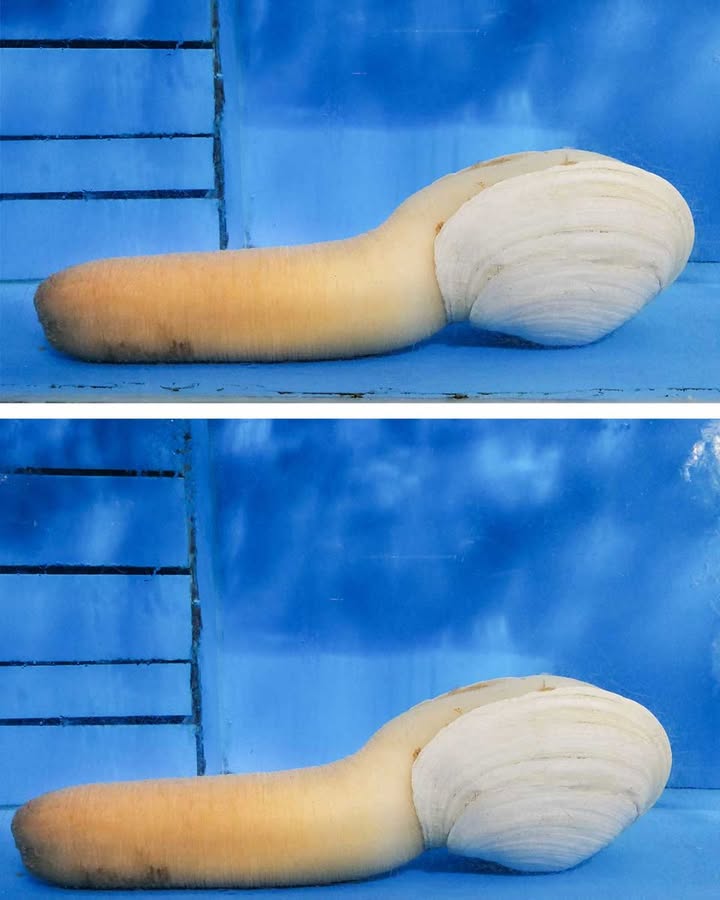ADVERTISEMENT
While dining at a local Chinese restaurant, you might expect to see familiar sights like vibrant lanterns or sizzling woks. However, a recent visit to such an establishment led to an unexpected encounter with something truly peculiar. Nestled among the more typical seafood offerings in a large tank was a creature that seemed straight out of a science fiction novel. Its bizarre appearance piqued the curiosity of diners, prompting questions about its identity and whether it was safe to eat.
The Mysterious Creature in the Tank: First Impressions
At first glance, the creature in the tank looked like a cross between a clam and an alien. Its elongated neck protruded from a large shell, waving gently in the water. This unusual sight left many patrons scratching their heads, wondering what exactly they were looking at. Was it some kind of rare sea creature, or perhaps a delicacy from the depths of the ocean? The restaurant staff, accustomed to such inquiries, were quick to reveal the creature’s identity: it was a geoduck.
Unveiling the Geoduck: What Is It?
The geoduck (pronounced ‘gooey-duck’) is a type of large saltwater clam native to the coastal waters of the Pacific Northwest. Known for its distinctive appearance, the geoduck is one of the largest burrowing clams in the world, with a siphon that can extend several feet beyond its shell. Despite its odd look, the geoduck is considered a delicacy in many cultures, prized for its sweet and briny flavor.
Origins of the Geoduck: A Journey Through History
The geoduck has a long history, particularly among the indigenous peoples of the Pacific Northwest, who have harvested it for centuries. Its name is derived from a Lushootseed word meaning ‘dig deep,’ reflecting the clam’s tendency to burrow into the sand. Over time, the geoduck has gained popularity in various culinary traditions, especially in Asian cuisine, where it is often served raw in sashimi or cooked in hot pots.
The Bizarre Shape of the Geoduck: Nature’s Oddity
Nature has a way of creating creatures that defy conventional aesthetics, and the geoduck is a prime example. Its shell is relatively small compared to its long, fleshy siphon, which can stretch up to three feet. This unique anatomy allows the geoduck to filter feed while buried deep in the sand, safe from predators. While its appearance might be off-putting to some, it is precisely this unusual shape that makes the geoduck so fascinating.
Culinary Uses: How People Eat Geoduck
In the culinary world, geoduck is celebrated for its texture and flavor. Chefs often serve it raw as sashimi, where its crisp, slightly sweet taste can be fully appreciated. It can also be quickly blanched and added to salads or stir-fried with vegetables. In Chinese cuisine, geoduck is a popular ingredient in hot pot dishes, where it is cooked briefly in boiling broth to retain its tender texture.
Safety Concerns: Is Geoduck Safe to Eat?
For those unfamiliar with geoduck, concerns about its safety are understandable. However, when sourced from reputable suppliers and prepared correctly, geoduck is perfectly safe to eat. Like all shellfish, it should be stored properly and consumed fresh to avoid any risk of foodborne illness. Additionally, it is important to ensure that the geoduck comes from clean waters, as clams can accumulate toxins from polluted environments
Conclusion: Embracing the Unusual in Culinary Adventures
Encountering a geoduck in a restaurant tank might be surprising, but it offers a unique opportunity to expand one’s culinary horizons. While its appearance may be unconventional, the geoduck is a testament to the diversity of nature and the rich tapestry of global cuisine. For those willing to embrace the unusual, trying geoduck can be a rewarding experience, offering a taste of something truly special.
ADVERTISEMENT
